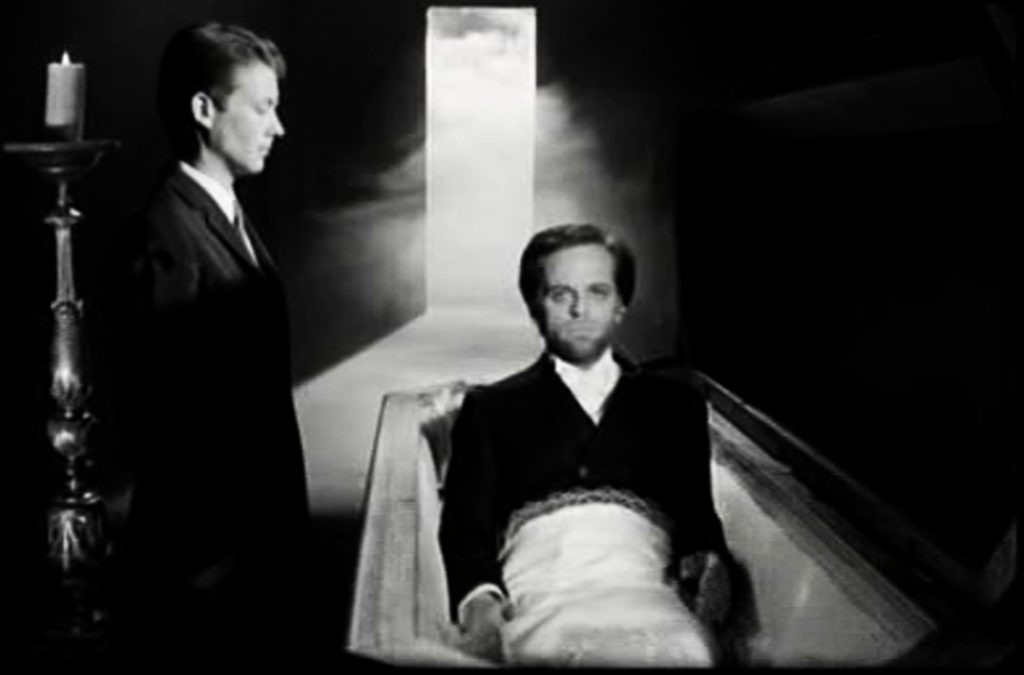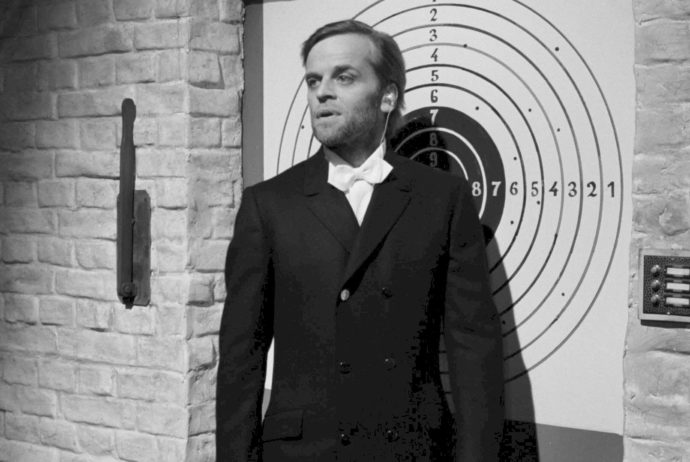Dir: Alfred Vohrer
Star: Heinz Drache, Barbara Rütting, René Deltgen, Klaus Kinski
a.k.a. Neues vom Hexer
I believe this is the only case of an Edgar Wallace krimi made by Constantin Films which was a direct sequel. For this was a follow-up to 1964’s The Mysterious Magician (Der Hexer), which I haven’t seen and is not reviewed here, because it did not include Kinski. This might have affected my enjoyment here somewhat, since I had no idea who the titular master-criminal was. A brief discussion thereof, seems pertinent. The IMDb synopsis runs as follows: “The sister of a famous, as-yet-uncaught criminal named The Hexer is murdered. Inspector Higgins of Scotland Yard believes that The Hexer will surface to take his revenge on his sister’s killers, and plans to set a trap to finally capture him. However, bodies soon start piling up, and it looks as if The Hexer might get away yet again.”
This was adapted from the Wallace novel published in 1925, and originally titled The Gaunt Stranger. The book had already been made into a film five times from then through 1952, and many of the cast from the 1963 version returned, including Deltgen as the mastermind, Arthur Milton. As this begins, he has left the British Isles for the less legally-troubling climate of Australia. However, he returns to England because of the murder of Lord Curtain, a crime at whose scene one of his calling cards was found. Unwilling to accept this attempt to blame him for a crime he didn’t commit, Milton decides he needs to clear his name by finding the real culprit. This puts him somewhat alongside Inspector James W. Wesby (Drache) of Scotland Yard, though for obvious reasons, Milton has to operate unofficially.

What’s interesting, is that this does not start off as a “whodunnit”. We know exactly who murdered Lord Curtain from the get-go, and how they did it. It was Archie, the nephew of the aristocrat, with the help of family butler Edwards (Kinski). He killed his uncle after stepping away from a game of cards. But with the aid of a tape-recording, containing a gunshot followed by a scream, he makes it seem as if the murder took place after his return, when he was sitting back at the table. That’s kinda clever. Except the judge presiding over the case notes that the bullet would have been immediately fatal, allowing no time for a scream. He then produces the tape-recorder – the judge is actually Milton, who is a master of disguise.
To this point, I was thoroughly impressed by the plotting on view, which was both imaginative and crisp. Unfortunately, the film as a whole is not able to sustain this level of creative writing. It soon turns out that Archie was not acting on his own. After he turns up dead – not the last corpse here, by any means – then we are back in the usual territory of multiple suspects, murky motives and more or less contrived twists on the way to the finale. Initially, it seems money is the motive, with the heirs to the Lord’s fortune also being knocked off. However, it eventually turns out to be more personal. The only member of the family who seems immune to the threat is Margie (Rütting), who has been cut off by Lord Curtain, after refusing to stop pursuing her dream of becoming an artist.
Outside of Kinski, one scene is certainly memorable – and, from a modern perspective, absolutely jaw-dropping. One of the Curtain family is a young boy, Charles, the family heir who lost an arm in a car accident. There is a failed attempt on his life, and at the end, he’s abducted. The kidnapper seeks to kill Charles by locking him in a room, and unleashing multiple tigers. The kid is genuinely in the same room with the big cats. No CGI obviously, but no stunt doubles or split screen either. At one point, he basically rides the tiger around! Quite what this means in terms of the story is hard to say: aristocratic children can soothe the savage beast? The boy is played by Teddy Naumann, whose family were animal trainers. Oh, and his missing arm is real: he lost it at age three (!), playing with a bear. [Fun fact, director Vohrer also lost an arm, fighting as a soldier in Russia during World War II]

As for Klaus, he certainly makes a sharp opening impression as butler Edwards, sitting up out of a coffin, and pronouncing it a good fit (above). He then is next seen playing the harp (!) for the amusement of his employers. But thereafter, he doesn’t get given too much to do, eventually turning up as one of those corpses mentioned earlier, being found in a dumb-waiter, used by those of nefarious intentions to move around the Curtain stately home. It is interesting that the film is almost a Battle of Butlers, for Milton has one of his own, Archibald Finch, played by comic relief stalwart Eddi Arent. Both manservants sport facial hair of some kind: Finch has a full beard, while Edwards has more of a five o’clock shadow going on, perhaps in deference to the character’s morally dubious nature and actions.
The film ends with an odd breaking of the fourth wall, Inspector Wesby, having stopped Milton from leaving for Australia, is asked what he wants with the man. He turns to the camera and says, “You will be told soon… in this theater.” This is an obvious set-up for a third movie in the franchise, and is all the more questionable, because it never happened. It appears the sequel was not quite able to repeat the success of its predecessor, and no further entries were made, apparently due to scheduling reasons. By this point, I’d lost most interest, and Wesby’s statement seemed more like a threat than a promise. Perhaps I’d have felt differently had I seen the original movie, rather than being introduced to a Ringer who was already very much in progress.
